We’ve all been there – craving that perfect cup of coffee only to realize our grinder’s broken or we’re somewhere without one. The good news? You don’t need expensive equipment to transform whole coffee beans into the perfect grind for your morning brew.
Many coffee lovers assume they’re stuck with pre-ground coffee when their grinder fails them. But we’re here to show you that your kitchen likely contains several tools that can get the job done. From the humble rolling pin to that trusty mortar and pestle tucked away in your cabinet these everyday items can save your coffee game.
Whether you’re dealing with a broken grinder camping in the wilderness or simply want to try something new we’ll walk you through proven methods that deliver surprisingly consistent results. Get ready to discover how resourceful coffee brewing can be – and maybe even find your new favorite grinding technique along the way.
What You’ll Need
We’ve prepared a comprehensive list of household items that can effectively replace your traditional grinder. These alternative tools and techniques will help you achieve consistent coffee grounds using items you likely already have in your kitchen.
Kitchen Tools and Equipment
Rolling Pin Method:
- Heavy rolling pin (marble or wooden works best)
- Large cutting board or flat surface
- Clean kitchen towel or freezer bag
- Measuring cups for portion control
Mortar and Pestle Technique:
- Large mortar and pestle (ceramic or stone preferred)
- Small bowl for collecting grounds
- Tablespoon for transferring beans
Hammer or Meat Tenderizer Approach:
- Clean hammer or meat tenderizer
- Thick kitchen towel or heavy-duty freezer bag
- Cutting board or solid surface
- Fine-mesh strainer for consistency
Blender or Food Processor Alternative:
- High-powered blender or food processor
- Pulse function capability
- Measuring spoons for small batches
Knife Crushing Method:
- Large chef’s knife with wide blade
- Stable cutting board
- Clean kitchen towel for containment
Coffee Bean Selection Tips
Bean Freshness Factors:
- Choose beans roasted within 2-4 weeks for optimal flavor
- Look for beans with visible oil sheen (indicates freshness)
- Avoid beans that appear dull or have excessive chaff
Roast Level Considerations:
- Light roasts require more pressure and time to break down
- Medium roasts offer the best balance for manual grinding
- Dark roasts crush more easily but may produce uneven particles
Bean Quantity Guidelines:
- Start with small batches (1-2 tablespoons) to test your technique
- Measure beans before grinding to maintain consistency
- Store remaining whole beans in airtight containers
- Keep beans at room temperature away from direct sunlight
- Use within one week of opening for manual grinding methods
- Avoid pre-grinding large quantities as grounds lose flavor quickly
Method 1: Using a Mortar and Pestle
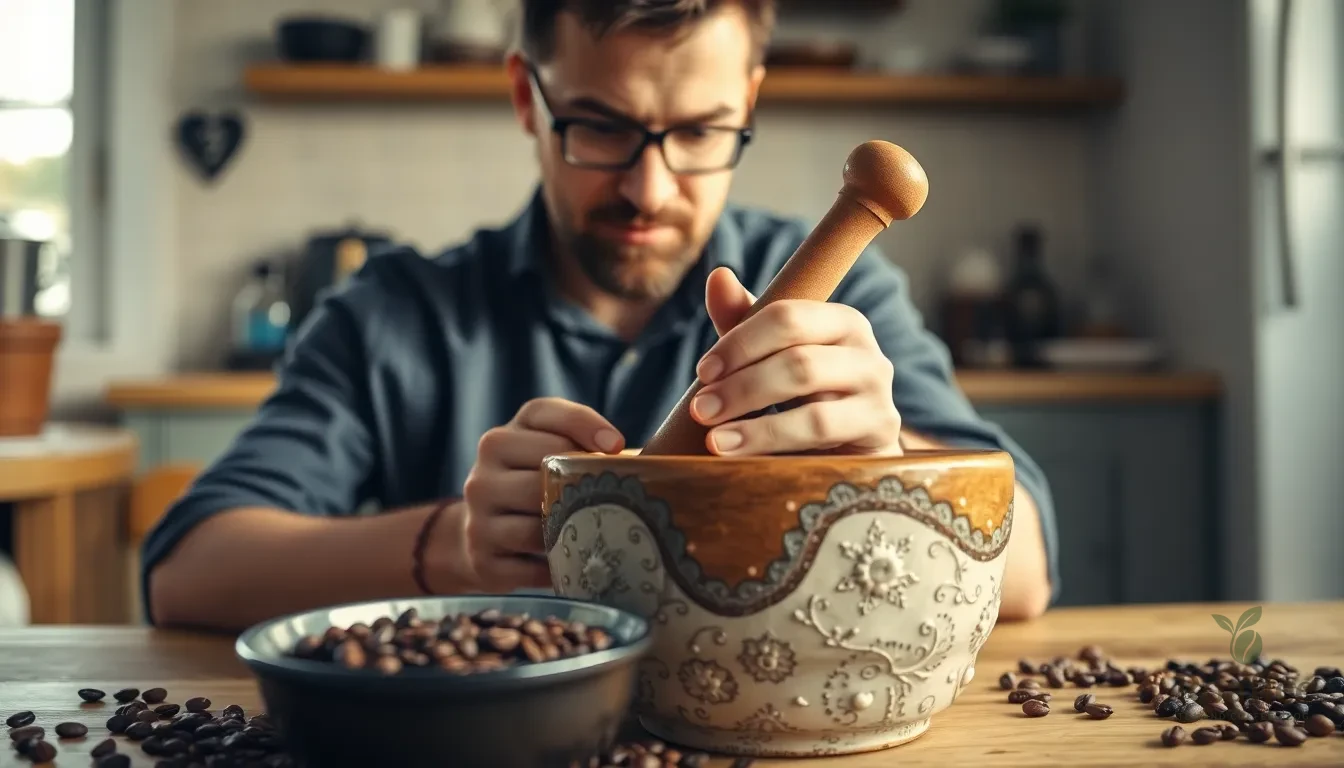
We recommend the mortar and pestle method as our top choice for grinding coffee without a grinder. This traditional technique gives us precise control over grind size and delivers consistent results.
Prep
First, we measure the desired amount of whole coffee beans using 1 to 2 tablespoons per 6 ounces of water. We work with small portions at a time to ensure even grinding and prevent overcrowding the mortar.
The ceramic mortar and pestle sets work best for this method due to their durability and resistance to coffee oils. We fill the mortar about one-fourth full with beans to maintain optimal grinding space.
Instructions
- Place the coffee beans into the mortar, filling it no more than one-fourth full for best results.
- Hold the mortar steady with one hand to maintain control throughout the grinding process.
- Press down firmly on the beans with the pestle using your other hand, applying a twisting motion to crush them initially.
- Switch to circular motions with the pestle after crushing, grinding the beans further to reach your preferred consistency.
- Continue grinding until the grounds reach the desired size:
- Coarse for French press
- Medium for drip coffee
- Fine for espresso
- Repeat the process as needed for larger quantities, working in small batches to maintain consistency.
We find this method requires effort and stamina, but it offers complete control over grind texture. The physical activity benefits our arm strength while producing quality grounds. We pay careful attention to avoid overgrinding, which can lead to bitter coffee, and monitor the consistency throughout the process.
Method 2: Using a Rolling Pin
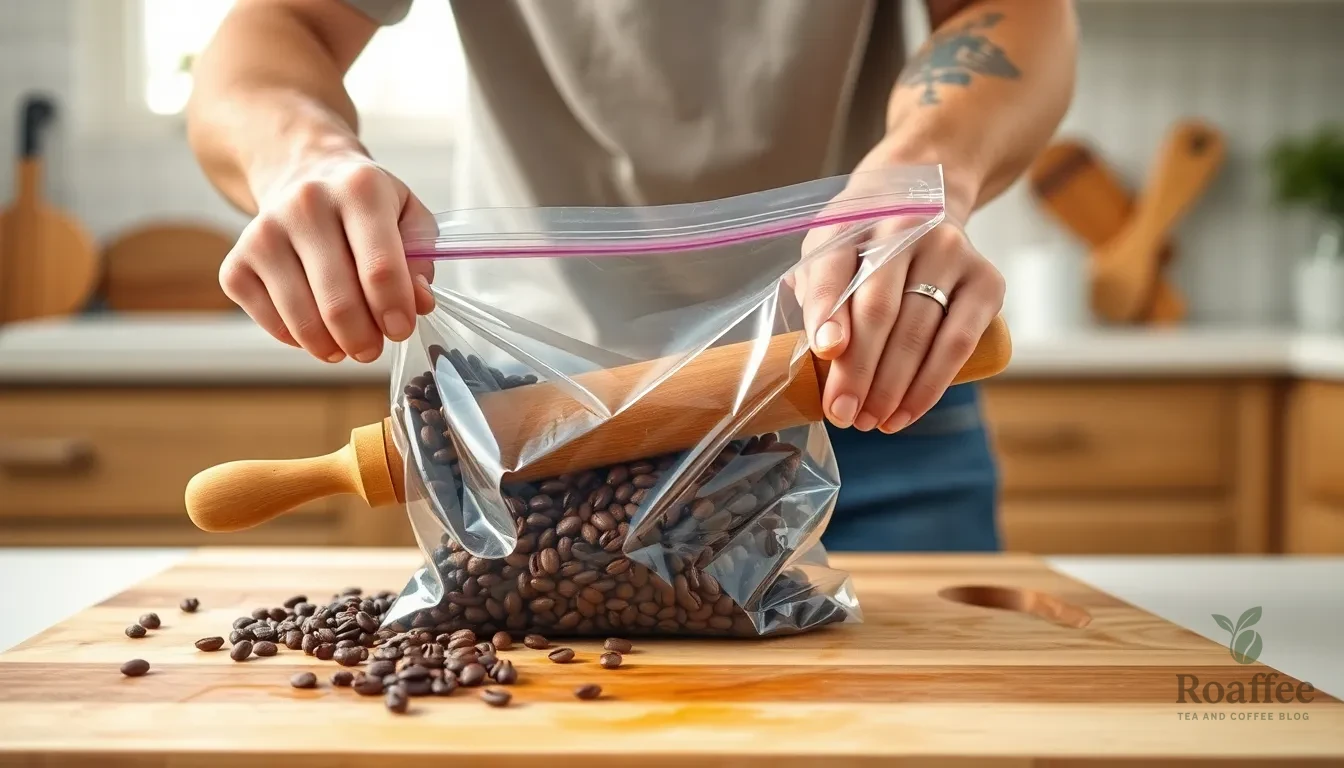
When you need a reliable grinding method that offers excellent control over coarseness, the rolling pin technique provides an accessible solution. This approach allows us to achieve uniform grounds suitable for various brewing methods including drip coffee and French press.
Prep
We begin by placing our coffee beans into a sturdy Ziploc bag or wrapping them in a clean tea towel to contain the beans and prevent mess. The bag or wrapped beans should be laid flat on a solid surface like a chopping board for stability.
Our next step involves spreading the beans evenly inside the bag to ensure uniform crushing throughout the grinding process. This even distribution helps us achieve consistent results across all the coffee grounds.
Instructions
We hold the rolling pin firmly and press down on the coffee beans inside the bag with deliberate pressure. Rolling and pressing with consistent force allows us to crush and grind the beans to our desired coarseness level.
For achieving more uniform grind texture, we apply even pressure while rolling back and forth several times across the entire surface. This repetitive motion ensures that all beans receive equal treatment during the grinding process.
When needed, we redistribute the beans inside the bag and continue rolling until we reach the desired grind texture. The rolling pin method gives us good control over the final coarseness, making it particularly effective for brewing methods that require exact grind sizes.
This technique strikes an excellent balance between control, accessibility, and grind quality when traditional coffee grinders are unavailable.
Method 3: Using a Hammer or Meat Tenderizer

When we need a quick grinding solution with readily available kitchen tools, a hammer or meat tenderizer provides an effective last-resort option for crushing coffee beans. This method works particularly well for achieving coarse to medium-coarse grinds suitable for French press or cold brew brewing.
Prep
We start by gathering our coffee beans and a sturdy Ziploc or freezer bag. Measure the desired amount of coffee beans and place them inside the bag. Squeeze out as much air as possible before sealing to prevent mess and unwanted bean movement during the grinding process.
Set up a large cutting board or sturdy flat surface to protect our countertop from the pounding action. We can optionally wrap the sealed bag in a kitchen towel to provide extra protection against tearing and reduce mess during the crushing process.
Instructions
Position the bag of beans on our prepared cutting board surface. Hold the hammer or meat tenderizer with a gentle but firm grip. Press down firmly on the bag instead of striking like we would drive a nail into wood.
Apply controlled force to crush the beans systematically. Work from one end of the bag to the other to ensure even coverage. Move the crushed beans around inside the bag between crushing sessions to achieve uniform grinding.
Check our progress regularly to maintain the desired coarse to medium-coarse grind consistency. Avoid applying excessive force that could pulverize the beans too finely and negatively impact the coffee’s flavor. Continue pressing and moving until we achieve the grind size appropriate for our chosen brewing method.
| Grind Size | Brewing Method | Crushing Time |
|---|---|---|
| Coarse | French Press | 2-3 minutes |
| Medium-Coarse | Cold Brew | 3-4 minutes |
| Medium | Pour Over | 4-5 minutes |
Method 4: Using a Knife
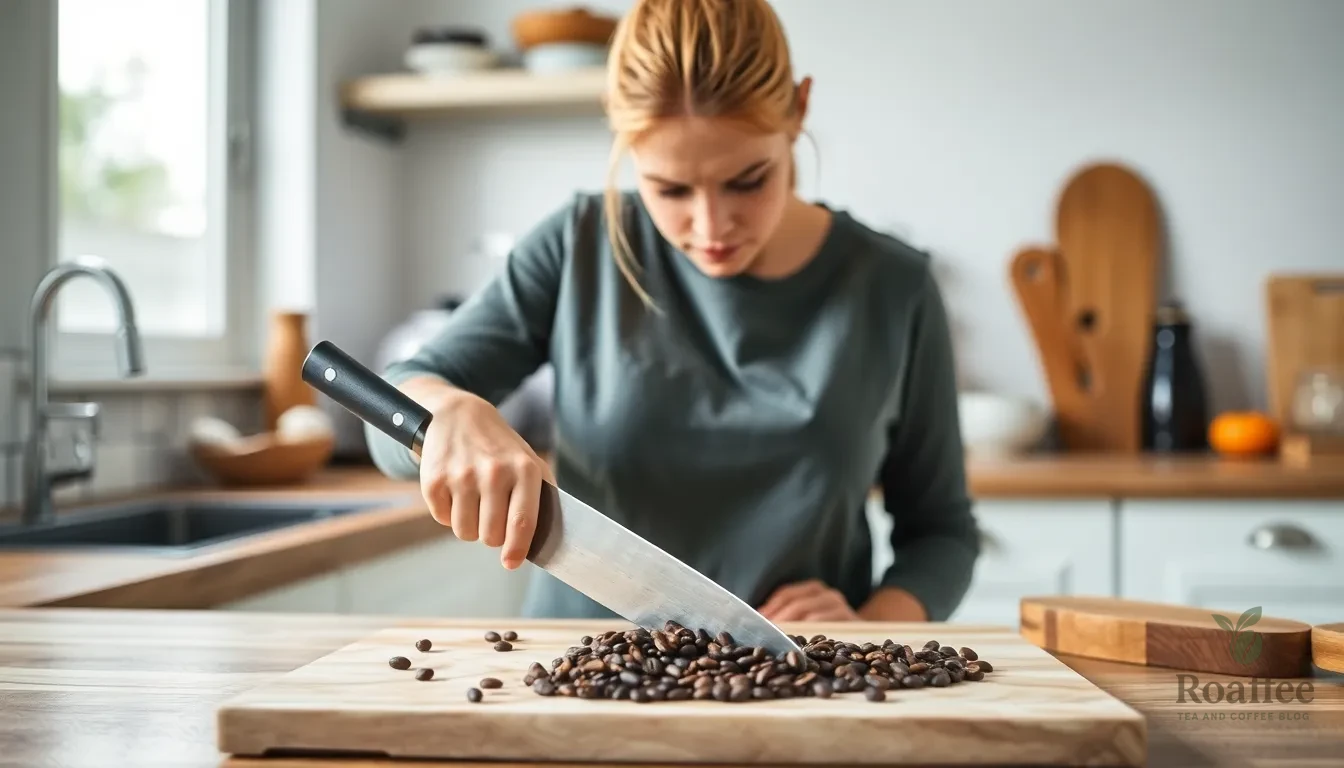
We can achieve effective coffee grinding results using a sharp chef’s knife when other household methods aren’t available. This technique requires careful attention to safety but offers excellent control over grind consistency.
Prep
We need to select a large sturdy chef’s knife for this grinding method. Our workspace should feature a clean flat cutting board positioned on a stable surface. Safety becomes our top priority so we must ensure the area remains free from distractions before beginning the grinding process.
Instructions
- Spread the coffee beans across the cutting board in a single even layer to prevent overcrowding.
- Apply gentle pressure using the flat side of the knife blade to lightly crush the beans. This initial step helps crack the beans and prepares them for more detailed chopping.
- Rock the chef’s knife back and forth over the cracked beans using controlled motions. We keep the knife tip in contact with the cutting board throughout this process to maintain safety and precision.
- Scrape the broken beans together periodically and continue chopping to achieve a finer grind consistency.
- Adjust the chopping intensity based on our desired grind size. Coarser grinds for French press require less intensive chopping while finer grinds for drip coffee need more careful attention.
- Check the consistency regularly and modify our chopping speed and pressure to achieve uniform results.
This knife method provides good control over grind size but requires patience and careful technique. We must remember that results will be less consistent than traditional grinders but remain highly effective when standard equipment is unavailable.
Method 5: Using a Food Processor or Blender
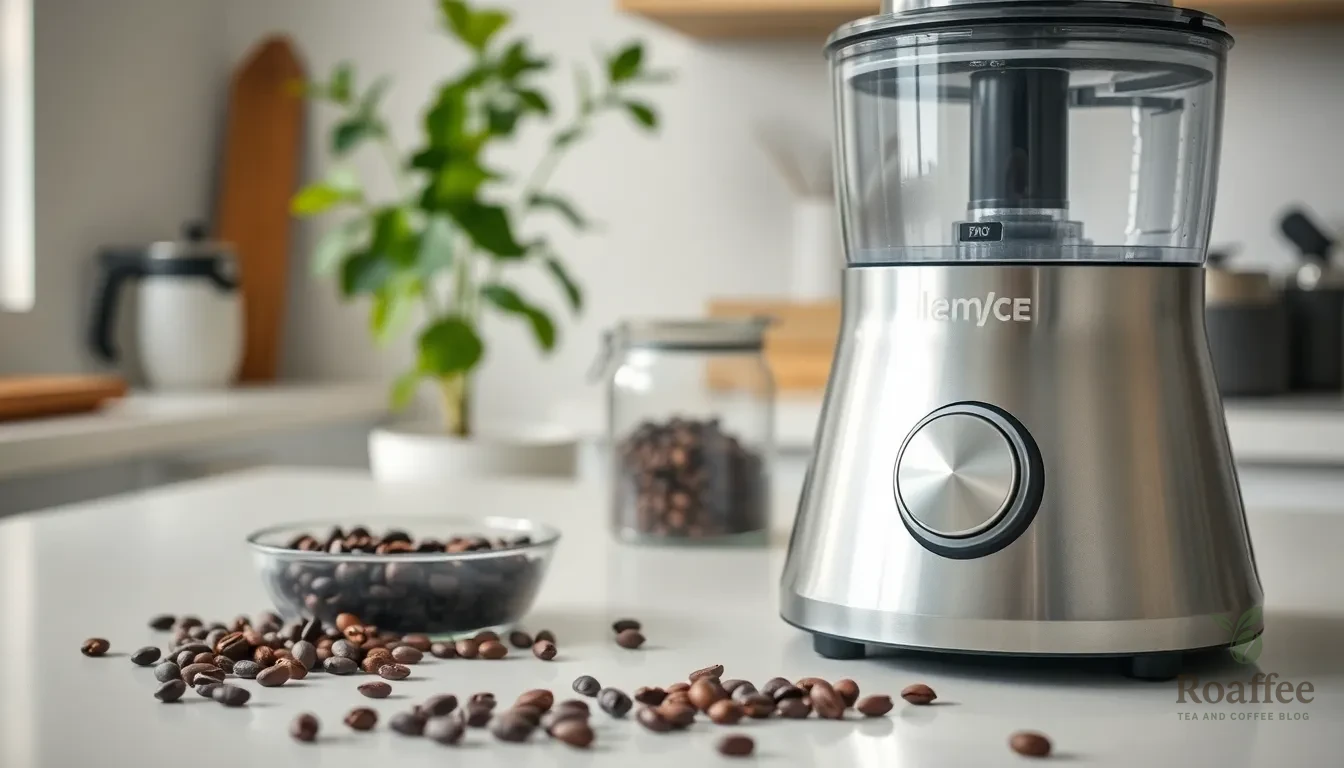
When traditional grinding methods seem too labor-intensive, we can turn to electric kitchen appliances for a more convenient approach. Food processors and blenders offer mechanized alternatives that can handle coffee beans with varying degrees of success.
Prep
We need to gather our coffee beans and select the appropriate appliance for grinding. Food processors work significantly better than blenders for this task since they’re designed to handle solid ingredients more effectively.
Essential items:
- Whole coffee beans (measured to your brewing needs)
- Food processor or high-powered blender
- Clean workspace
- Storage container for finished grounds
Before we begin, we should ensure our coffee beans are roughly similar in size to promote more even grinding. Remove any damaged or discolored beans that might affect the final result.
Instructions
Food Processor Method:
We start by adding our measured coffee beans to the food processor bowl. Fill the processor with only the amount we plan to use immediately since freshly ground coffee loses flavor quickly.
Pulse the beans in short 10-20 second bursts rather than running the processor continuously. This controlled approach prevents overheating the beans and gives us better control over the grind size.
Between each pulse, we should check the consistency by removing the lid and examining the grounds. Shake or stir the beans gently to redistribute them for more even grinding.
Continue pulsing until we achieve our desired coarseness:
| Grind Size | Brewing Method | Pulse Duration |
|---|---|---|
| Coarse | French Press | 3-4 pulses |
| Medium | Drip Coffee | 5-6 pulses |
| Fine | Espresso | 7-8 pulses |
Blender Method:
Blenders present more challenges since they’re designed primarily for liquids. We can still use a powerful blender by placing the beans inside and pulsing them briefly.
Use extremely short bursts to avoid excessive heat buildup that can negatively impact coffee flavor. The grinding will be less consistent than with a food processor, but it works for basic grinding needs.
We must be particularly cautious with blenders since they tend to create uneven grind sizes and may struggle with the hardness of coffee beans.
Final grinding tips:
Stop frequently to check our progress and avoid over-grinding, which can lead to bitter coffee. Food processors may not produce perfectly uniform grounds like dedicated coffee grinders, but they serve as an excellent alternative when our regular grinder is unavailable.
Grind only what we need for immediate use to preserve the coffee’s freshness and flavor profile.
Tips for Achieving Different Grind Sizes
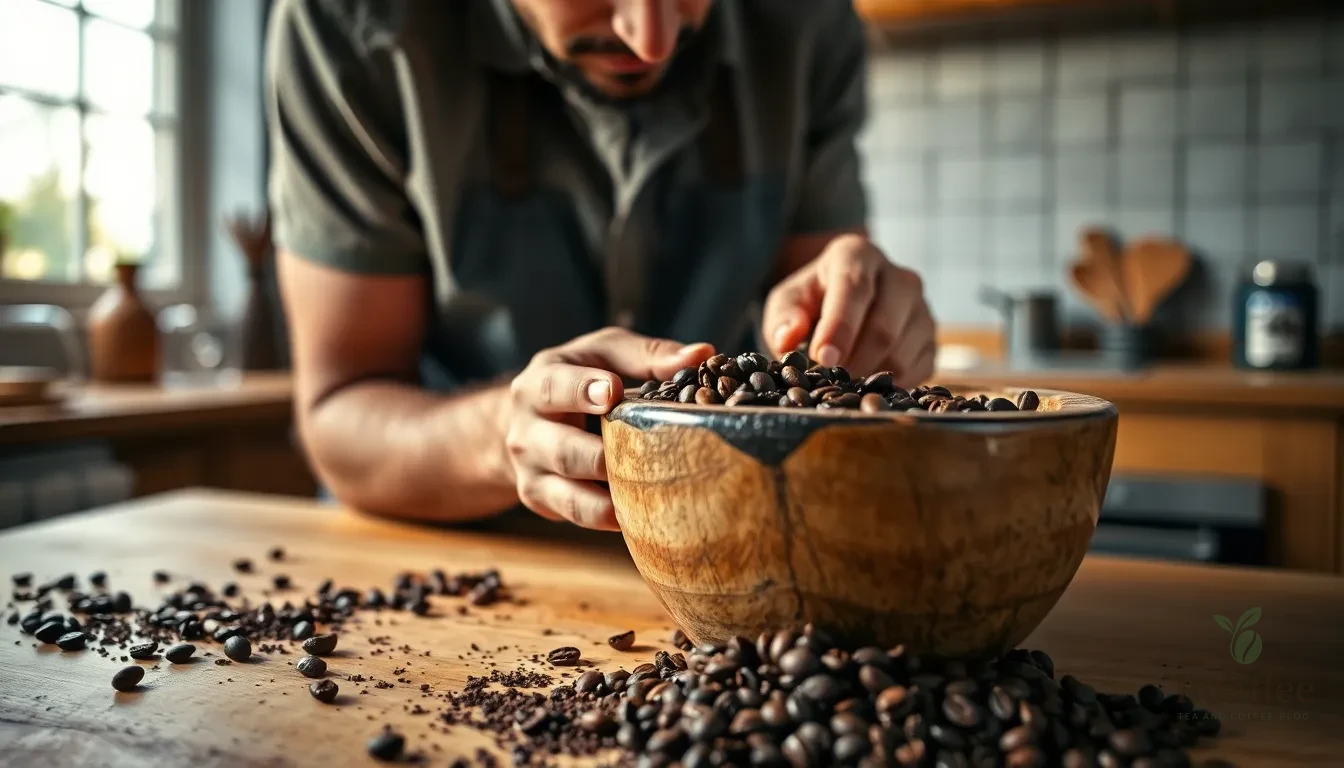
Different brewing methods require exact grind sizes to extract optimal flavor from our coffee beans. We’ll break down the key techniques for achieving coarse, medium, and fine grinds using the household methods we’ve covered.
Coarse Grind
Coarse grinds work best for French press and cold brew methods where longer extraction times are needed. We aim for particles roughly the size of sea salt when creating this texture. Using a mortar and pestle provides the most control for achieving consistent coarse grounds through gentle crushing motions rather than aggressive grinding.
The rolling pin method excels at producing coarse grinds by applying light pressure and rolling slowly across the bagged beans. We stop crushing once the beans break into chunky pieces that maintain their structure. Hammer or meat tenderizer techniques work well for coarse grinds by delivering controlled taps that crack the beans without pulverizing them into powder.
Medium Grind
Medium grinds suit drip coffee makers and pour-over brewing methods perfectly. We target a consistency similar to table salt or coarse sand for optimal water flow and extraction. The mortar and pestle method requires more sustained grinding pressure compared to coarse grinds while maintaining steady circular motions.
Rolling pin technique works effectively for medium grinds by applying moderate pressure and checking the consistency frequently. We roll the beans until they break down into uniform pieces that feel grainy but not powdery between our fingers. Blender methods can achieve medium grinds through careful pulsing in short bursts to prevent overheating the beans.
Fine Grind
Fine grinds are essential for espresso machines and AeroPress brewing where rapid extraction occurs. We need particles that feel similar to fine sand or slightly coarser than table salt. The mortar and pestle method requires the most effort for fine grinds through small repeated crushing motions that gradually break down the bean structure.
Creating fine grinds takes patience and careful monitoring to avoid overgrinding into powder form. We crush the beans systematically using firm pressure while checking the texture regularly to maintain consistency. Avoiding excessive grinding prevents bitterness that occurs when particles become too fine and over-extract during brewing.
Storage and Freshness Tips
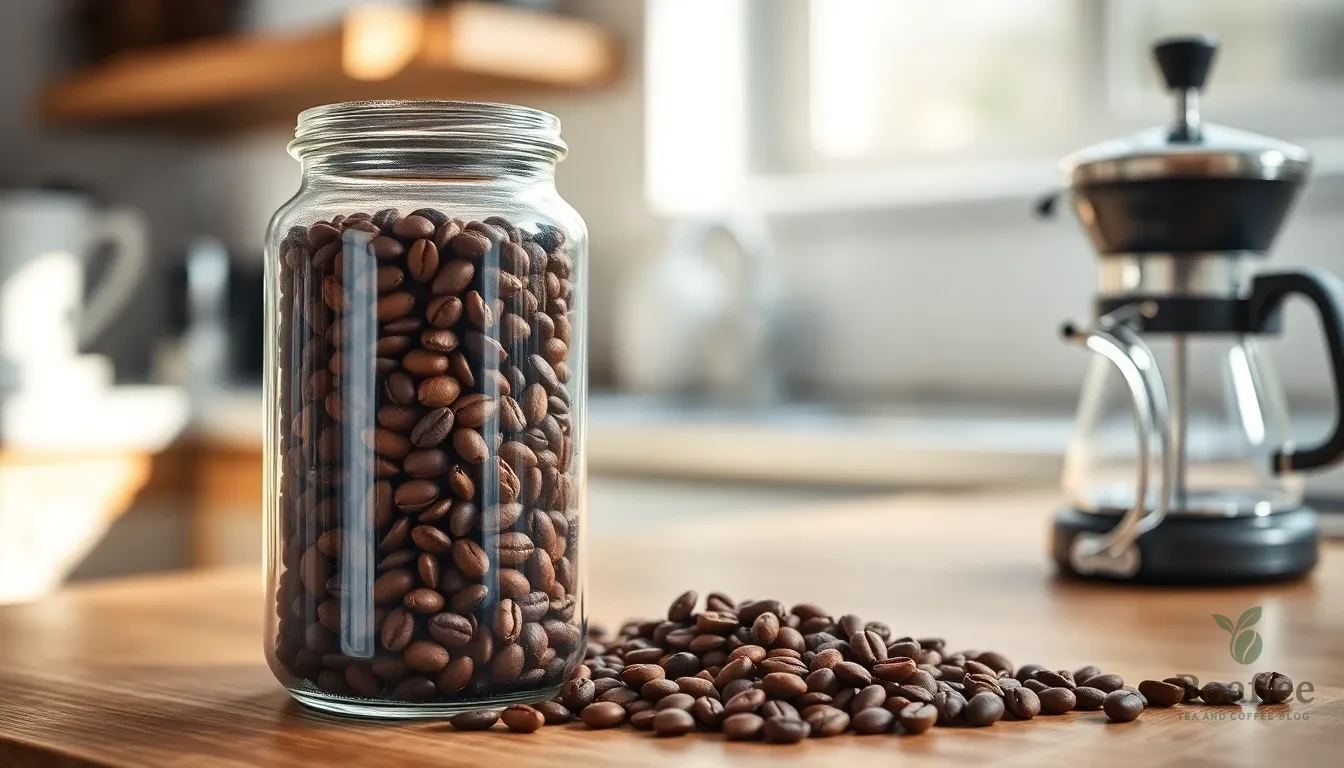
We recommend using freshly ground coffee immediately after grinding to maximize flavor and aroma. Coffee rapidly loses freshness once exposed to air due to oxidation and the release of volatile compounds that create its distinctive taste profile.
Immediate Use Strategy
Our experience shows that grinding only what you need for each brewing session delivers the best results. Whole beans retain their oils and flavors significantly longer than ground coffee which starts deteriorating within minutes of exposure to air.
Proper Storage Techniques
Store any leftover ground coffee in an airtight container to preserve freshness as much as possible. We suggest using containers with tight-fitting lids placed in cool dark locations away from heat sources and direct sunlight.
| Storage Method | Freshness Duration | Best Practice |
|---|---|---|
| Airtight container at room temperature | 3-5 days | Cool dark pantry location |
| Refrigerator storage | 1-2 weeks | Sealed container to prevent moisture |
| Freezer storage | 1 month | Vacuum-sealed bags for best results |
Grinding Quantity Guidelines
Avoid grinding large quantities in advance since whole beans maintain their flavor compounds much longer than ground coffee. We recommend grinding enough for your immediate brewing needs plus perhaps one additional serving to minimize waste while preserving quality.
Environmental Factors
Protect ground coffee from the four main enemies of freshness: air, moisture, heat, and light. Our testing confirms that exposure to these elements accelerates flavor degradation and can create stale or bitter tasting coffee regardless of your grinding method.
Quality Preservation Tips
Check stored ground coffee for any off odors or moisture before brewing. Fresh coffee should smell aromatic and feel dry to the touch. Any musty or sour smells indicate the coffee has deteriorated and should be discarded for optimal brewing results.
Troubleshooting Common Issues
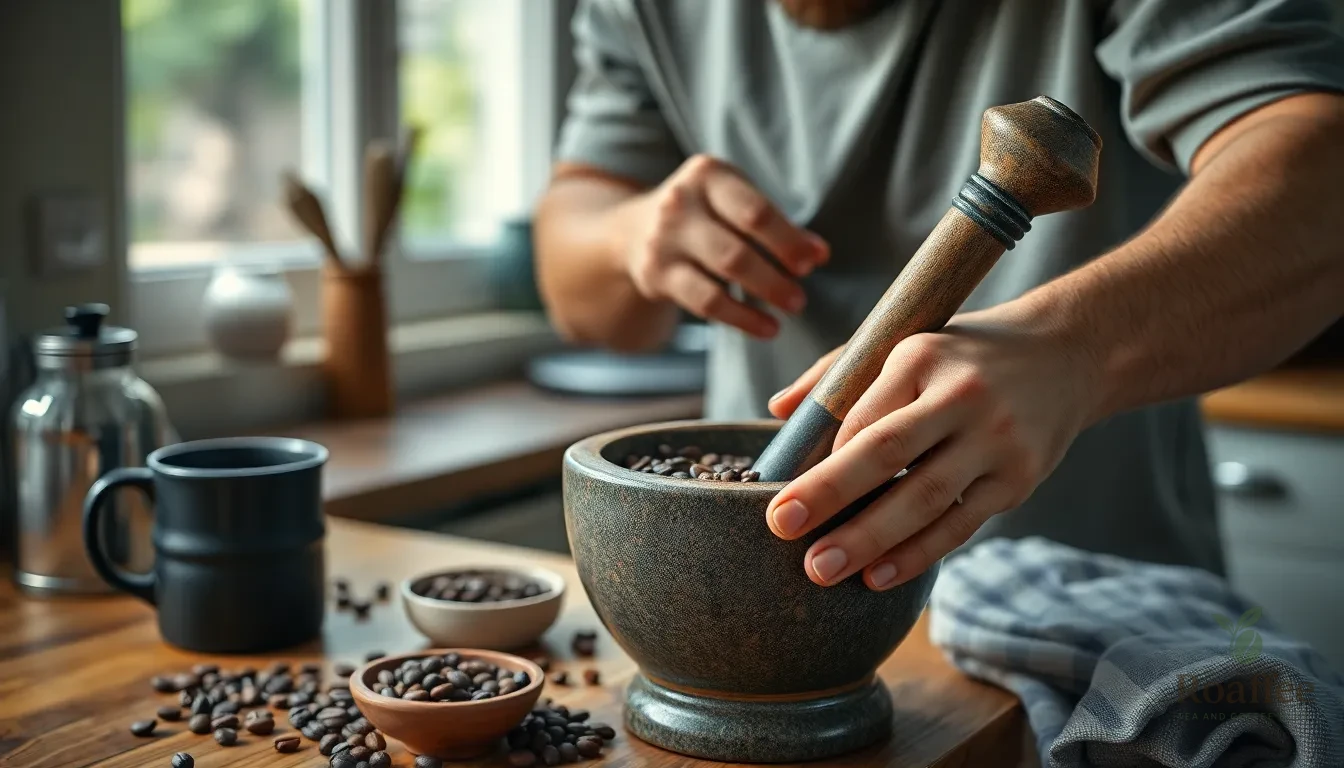
Even with the best intentions and careful technique, grinding coffee without a dedicated grinder can present several challenges that we need to address effectively.
Uneven Grind Size represents the most common frustration when using household methods. Manual grinders often suffer from burr misalignment, so we recommend checking the alignment and maintaining a steady grinding motion throughout the process. When using manual methods like mortar and pestle or rolling pin techniques, we achieve better consistency by grinding in small batches and applying uniform pressure across all beans. Overgrinding creates powdery fines that can make our coffee taste bitter and muddy.
Inconsistent Results from Electric Appliances frequently occur when we use blenders or food processors for grinding. These appliances work best when we pulse the beans in short bursts rather than running them continuously. Between each pulse, we should shake the container to redistribute the beans and ensure more even grinding. High-powered blenders with exact grinding settings typically yield superior results compared to standard models.
Mess and Spillage can quickly turn our coffee grinding session into a cleanup nightmare. We prevent this issue by using sealed plastic bags when employing hammer or rolling pin methods. Double-bagging provides extra protection against tears and spills. For mortar and pestle grinding, we cover the opening with a kitchen towel to contain any beans that might jump out during the crushing process.
Arm Fatigue and Time Investment become important factors when grinding larger quantities manually. We recommend starting with smaller batches to build technique and stamina. Taking breaks between grinding sessions helps maintain consistent pressure and prevents overexertion. Planning ahead allows us to spread the grinding process across multiple sessions rather than rushing through large quantities.
Heat Generation from friction can affect our coffee’s flavor profile negatively. We avoid this by taking breaks during extended grinding sessions and allowing our tools to cool down. Pulsing methods with blenders and food processors prevent excessive heat buildup that can compromise the coffee’s essential oils and aromatic compounds.
Achieving Target Grind Size requires patience and frequent checking throughout the process. We sample small amounts periodically to assess our progress and adjust our technique accordingly. Different brewing methods demand exact grind sizes, so we match our grinding intensity to our intended brewing style rather than grinding everything to the same consistency.
Conclusion
We’ve shown you that a broken grinder doesn’t have to derail your coffee routine. With simple household items like a rolling pin or mortar and pestle you can still enjoy freshly ground coffee at home.
The key is choosing the right method for your situation and taking your time to achieve consistent results. Whether you’re camping or dealing with equipment failure these techniques will keep your coffee game strong.
Remember to grind only what you need and use it immediately for the best flavor. Now you’re equipped with multiple backup plans that’ll ensure you never have to settle for stale pre-ground coffee again.
Frequently Asked Questions
Can I grind coffee beans without a traditional grinder?
Yes, you can grind coffee beans using common kitchen tools like a rolling pin, mortar and pestle, hammer, blender, or food processor. While these methods require more effort than electric grinders, they can produce consistent results and work well in emergencies or when camping.
What’s the best method for grinding coffee without a grinder?
The mortar and pestle method is the top choice because it provides precise control over grind size and delivers consistent results. It allows you to adjust the texture from coarse to fine and gives you complete control over the grinding process.
How do I use a rolling pin to grind coffee beans?
Place coffee beans in a sealed plastic bag or tea towel, lay them flat on a solid surface, and roll over them with consistent pressure. This method offers excellent control over coarseness and works well for drip coffee and French press brewing.
Can I use a blender or food processor to grind coffee?
Yes, both work effectively for grinding coffee beans. Use short pulses to avoid overheating and achieving uneven grinds. Food processors typically provide better control than blenders, but both can produce suitable grounds for various brewing methods.
How do I avoid uneven grind sizes when grinding manually?
Grind in small batches, apply consistent pressure, and take your time. For methods like the mortar and pestle, use a rotating motion while crushing. With rolling pins, maintain steady pressure and roll evenly across all beans.
Should I grind all my coffee at once or in batches?
Always grind in small batches and use the grounds immediately for best flavor. Grinding large quantities in advance causes coffee to lose its freshness, aroma, and taste. Only grind what you need for immediate brewing.
How long does it take to grind coffee manually?
Manual grinding typically takes 2-5 minutes depending on the method and desired grind size. The mortar and pestle method takes longer for fine grinds, while the hammer method is quickest but requires more control for consistency.
What grind size should I aim for with different brewing methods?
Coarse grinds work best for French press and cold brew, medium grinds for drip coffee and pour-over, and fine grinds for espresso. Manual methods allow you to adjust texture by varying pressure and grinding time.

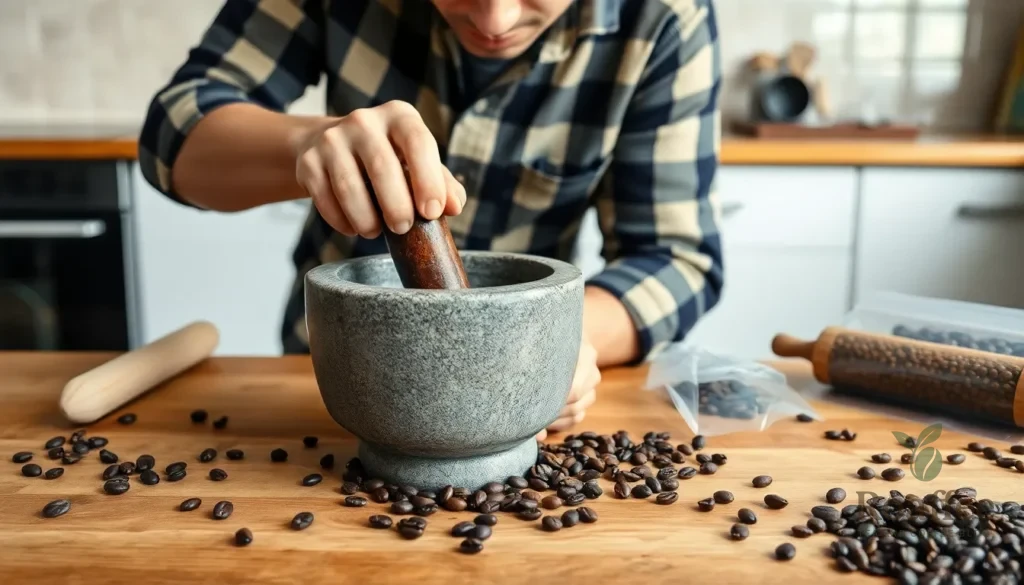







![Longzon 4-in-1 Knife Sharpener [4 Stage] with a Pair of](https://m.media-amazon.com/images/I/51qTEnCeP2L._SL500_.jpg)
















